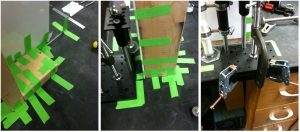Archive for July, 2012
Leveling the tapper
Posted by () in Open Notebook Science on July 10, 2012
All our efforts have made the tapper quite a robust machine. Unfortunately, there are still problems with it that Damian pointed out in his last post on July 6, 2012. The issue is that the table on which the tapper sits is not level. This causes our measurements of the tapped powders to acquire a slant that is undesirable. This issue would instantaneously be fixed with a leveled optical table—of which I will follow Bill Hooker’s advice and crowd-source the funds for it—unfortunately, we don’t have one. So, I tried the next best thing which is a large piece of aluminum that is about 0.5″ thick and 2′ x 1.5′. It was the bottom support for an old circuit board maker that was made in West Germany in the 80’s. That’s right kiddos, West Germany. I will post pictures at a later date. Nonetheless, the support had tapped screw holes that I am using as a rough way to level the aluminum. I roughly leveled the plate and now need to populate it with the tapper. The unfortunately thing is that the plate does not have tapped hole, which means we will have to think of a way to keep all the components on it without moving. I bet magnets would work but I’m not sure they would work any better than the tape we are already using. Well, here’s to experimenting!
Debugging the tapper
Posted by () in Open Notebook Science on July 2, 2012
Friction in the tapper
Jihyun noticed that the tapper had an issue with “friction” when it was tapping. Turns out that the baseplate that I used to connect the post holders together would become skewed durning taps and thus would cause misalignment of the post holders with the optical posts. This caused the tapper to not tap properly. Below is an image of the baseplate highly skewed for illustrative purposes.
To alleviate this, I have switched out the baseplates with one that does not have the capability of lateral motion—see the below figure.
This baseplate does not allow for left/right motion (with respect to the line made with the screws) and thus does not cause the tapper to become misaligned and have excess “friction”.
Stability
Another issue with the tapper is stability. Ideally, I would have everything mounted on an optical table and thus everything would be in the same plane, alignment would be a non-issue, and we wouldn’t have to deal with a lot of movement issues that are cropping up. For one thing, the setup—once it is ready for data taking—should never move when taking data. Neither should the focus of the camera change when data is being taken. These problems have occurred with some data we have taken and thus cause us to retake the data. This is a problem because it will cause inconsistencies with our data.
To alleviate this, I have taped/clamped everything down.
This should help with keeping the screen and tapper in one place. I highly recommend that they do not move while taking data. If they do, then the images taken before and after the movement will be different and will cause inconsistencies.
Another issue I saw with the setup is that sometimes the screen would not be perpendicular to the light source. This is not good as it will cause keystoning with the shadow. I’d much rather not correct for this and would prefer the screen to be perpendicular to the light source at all times.
Tilting powders when tapping
Sometimes after some taps, the powder in the cylinder will no longer be level with respect to the small optical breadboard. This is a bad thing as we are trying to measure compaction with each tap. I believe that this is caused by improper alignment of the cylinder as can be seen in the below image.
It’s faint but I made a plumb line and illuminated that with the cylinder. The shadow on the screen shows that the plumb is not straight with the cylinder and thus is not exactly vertical. This could be the cause of the powders tilting when being tapped. This is a difficult thing to fix and may need some redesign of the system.



